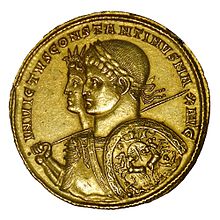Multiplum

Multiplum (pl. "Multipla") is a current term for irregular multiple pieces of common denominations of coins from the Roman Empire .
Multipla have been minted since the reign of Augustus as a gift ( donative ) to special dignitaries, since the reign of Gallienus also as pay to officers and from the end of the fourth century onwards also as a tribute to Germanic peoples.
While gold multiples with a weight of 2, 4 or 8 (less often 5, 6, or 10) aurei appeared from the first to the third century, pieces with a value of 3, 4½, 9, 12 were usually used after the Constantinian coin reform , 18, 36 or 72 solidi (327.5 grams of gold ). The largest of the rarer silver multipla initially had a value of 8 denarii and later of up to 48 siliquae (100 grams of silver ).
Large coins made of base metal were used for ceremonial purposes or as gifts for ordinary citizens.
The Brunswick solvers (up to 16 times the thaler ) are also known as Multipla .
literature
- David L. Vagi: Coinage And History Of The Roman Empire . Chicago & London 1999. p. 109 ff.
- David R. Sear: Roman Coins And Their Values . (Millennium Edition). Volume 1, London 2000. p. 314; Volume 2, London 2002, pp. 152, 638; Volume 3, London 2005, pp. 113, 149, 279, 397, 419, 497, 502, 509; Volume 4, London 2010
- Chris Scarre: The Roman Emperors . Düsseldorf 1996. p. 174, ISBN 3-430-17908-4 .
Web links
- Worldwide unique find at Stade. Earliest archaeological evidence of the existence of a Saxon elite in Lower Saxony , in: Archäologie online, June 21, 2019 (struck 342/343 in Siscia for Constans, found in December 2017 at Fredenbeck )
Individual evidence
- ↑ Helmut Kahnt, Bernd Knorr: Old dimensions, coins and weights. A lexicon. Bibliographisches Institut, Leipzig 1986, licensed edition Mannheim / Vienna / Zurich 1987, ISBN 3-411-02148-9 , p. 388.
